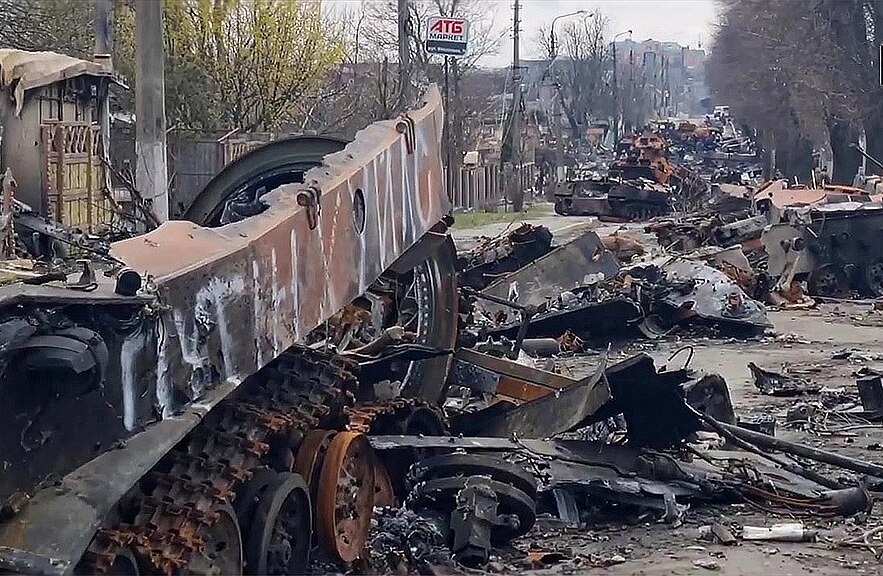More than two months after Russia launched the invasion of Ukraine, the Kremlin has still not achieved any of its military and political goals in the neighboring country. Ukrainian forces, on the other hand, are still far from reestablishing full control over territories that are currently under Russian occupation, which suggests that the war in the Eastern European nation will not be over any time soon.
After Ukrainian President Volodymyr Zelensky openly said that his country will “definitely not go into such a diplomatic swamp as a frozen conflict with Russia”, it became obvious that Kyiv is determined to fight until the end. Moscow, for its part, is still calculating and allegedly hopes to reach a deal with Ukraine in a way that would allow the Kremlin to save face.
Russia’s recent claims that “Western arms supplies to Ukraine prevent a quick end to the conflict” can be interpreted as a clear sign of Moscow’s military and political debacle in Ukraine. Quite aware that Russia has demonstrated serious weakness, the West is unlikely to push Kyiv to sign any agreements with the Kremlin. Moreover, Western countries will continue supplying Ukraine with all kinds of weapons, making sure that its armed forces are capable of recapturing territories that are currently under Russian control.
Reports suggests that the Ukrainian Army has already made some gains in the Kharkiv region in the east of the country, while Russian troops are having a hard time continuing with their offensive in the Donbass. Indeed, without massive reinforcement – which is unlikely to come any time soon, if it all – Russia risks suffering a defeat in the region.
Presently, Russian forces effectively control significant portions of the Donbass as well as the south of Ukraine, namely the Kherson region and large parts of the Zaporizhia region. It is worth noting, however, that Russian troops captured those territories during the first two weeks of the so-called special military operation, and Ukrainian forces, for some reason, did not provide any resistance but withdrew from strategically important costal areas.
Moscow is now trying to gradually incorporate the south of Ukraine into the Russian economic, informational and monetary systems. The problem for Russia, however, is the fact that it desperately lacks manpower, which means that, if Ukraine launches a large-scale offensive in the region, Russian forces will be unlikely to manage to preserve control over the region.
The Kremlin repeatedly insists that it does not plan to announce a nationwide mobilization but the situation in the east and the south of Ukraine may force Russian leaders to change their military strategy and find a way to deploy more troops to the former Soviet republic. However, even with more forces on the ground, Russia can still suffer a humiliating defeat in Ukraine.
The Russian army has demonstrated incompetence and very poor performances in Ukraine. It has proved that it cannot – or does not want to – destroy bridges and railway infrastructure in the Eastern European country. For instance, even though Russian forces conducted three rocket strikes on strategically important bridge across the Dniester estuary in the Odessa region of southwest Ukraine, the damaged section appears to be rather small. Despite occasional cruise missile attacks, Kyiv continues supplying its troops in the east, which means that the country’s railway network has not been seriously damaged. In addition, Russian forces cannot target military convoys with long-range ballistic missiles. For such an action, they would need to use aviation, which is not very easy, given that Ukraine still has very efficient air-defense systems.
Thus, the Kremlin continues implementing half-measures in Ukraine, which leads to what Belarusian President Alexander Lukashenko described as dragging on of the war. In spite of that, Russia keeps threatening to destroy “NATO transport carrying weapons in Ukraine”, although it has not taken any steps to prevent the United States-dominated Alliance from arming the country. Moreover, Russia still has not fulfilled its promise to target “decision-making centers” in Kyiv, which is why Ukraine and the West stopped taking Moscow’s empty threats too seriously.
Finally, it is unlikely that the Kremlin will dare to risk a direct confrontation with NATO, even if certain members of the Alliance eventually deploy their troops to Ukraine. Since invading the former Soviet republic, Russian forces have failed to achieve any of the Kremlin’s original strategic goals; they have clearly demonstrated that they cannot defeat Ukraine, let alone NATO.
That is why the Kremlin seeks to find a diplomatic solution to the war even though the very nature of the conflict suggests that it can end only if one of the two parties involved agrees to de facto capitulate. But we are still far from such an outcome.
Image: Ukrinform TV / Ukrainian Armed Forces

